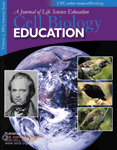Abstract
The advent of genomics, proteomics, and microarray technology has brought much excitement to science, both in teaching and in learning. The public is eager to know about the processes of life. In the present context of the explosive growth of scientific information, a major challenge of modern cell biology is to popularize basic concepts of structures and functions of living cells, to introduce people to the scientific method, to stimulate inquiry, and to analyze and synthesize concepts and paradigms. In this essay we present our experience in mixing science and education in Brazil. For two decades we have developed activities for the science education of teachers and undergraduate students, using microscopy images generated by our work as cell biologists. We describe open-air outreach education activities, games, cell modeling, and other practical and innovative activities presented in public squares and favelas. Especially in developing countries, science education is important, since it may lead to an improvement in quality of life while advancing understanding of traditional scientific ideas. We show that teaching and research can be mutually beneficial rather than competing pursuits in advancing these goals.



